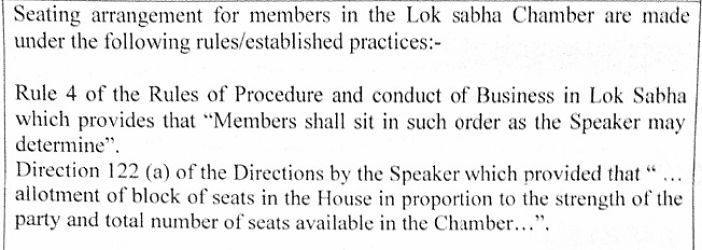Now that the elections are complete, the focus will turn to the first sitting of the 17th Lok Sabha. Seat allotment in the Lok Sabha sometimes could be a contentious affair. Seats in the front row are the most sought after. But who decides the seating arrangement in the Lok Sabha?
After the 2014 Lok Sabha elections resulted in a drubbing for the Congress party, there were reports that the party was demanding two extra seats in the front row of the Lok Sabha. History might repeat again with Congress ending up with just 52 seats in the 2019 general elections. Getting front row seats is an issue of prestige for most parties and senior members of the house. Then, how is the seating arrangement in the Lok Sabha decided?
The Lok Sabha Chamber Seating Capacity
The Lok Sabha chamber has a seating accommodation for 550 Members. The seats are divided into six blocks, each with eleven rows. Block No. 1 on the right-hand side of the Speaker’s Chair and Block No. 6 on the left-hand side have 97 seats each. The remaining 4 blocks have 89 seats each. A seat is allotted in the chamber to each Member, including Ministers who are Members of Lok Sabha. The seats on the right-hand side of the Speaker’s Chair are occupied by the Members of the ruling party and those on the left-hand side by Members belonging to the Opposition Parties/Groups. The Deputy Speaker occupies the first front row seat on the left side.
Who decides the seating arrangement?
As per Rule 4 of the Rules of Procedure and Conduct of Business in Lok Sabha, The members shall sit in such order as determined by the speaker of the house. The speaker is guided by the direction 122(1)(a) of the ‘Directions by the Speaker’. This direction clearly authorizes the speaker to allot seats in the house in proportion to the strength of the Party and the total number of seats available in the Chamber.
How is this allotment done?
The following formula is applied to decide allotment of seats for parties that have a strength of 5 or more members in the house.

If we take the front row of seats for example, there are a total of 20 front row seats across the six blocks. Going by the above formula, the BJP has 303 in the 17th Lok Sabha and together with its allies, the NDA has more than 350 members in the house. The NDA, therefore will be entitled to 13 front row seats out of the available 20.

Going the same formula, the Congress which has 52 members in the house after the Lok Sabha results is entitled for only two front row seats. Similarly , the other parties will be allocated seats in each row accordingly.
What happens after that?
Similar process is followed for each of the rows. After the number of seats to be allotted to each party is worked out, they are released to the party. Based on the recommendations received from the party, seats are allotted to the individual members with the approval of the Speaker.
What about parties with fewer than 5 members?
Seat allotment to members belonging to smaller parties (with strength of less than 5 members) and independents is done by the speaker as per her discretion in accordance with established principles like
- The Member’s standing in Parliament (Seniority etc.)
- Prominence in Public Life
This is the reason why people like H D Deve Gowda & Mulayam Singh Yadav were given front row seats in 2014 even though their respective parties did not have the required numbers.





1 Comment
Pingback: How is the Seat Allotment in the Lok Sabha Done?